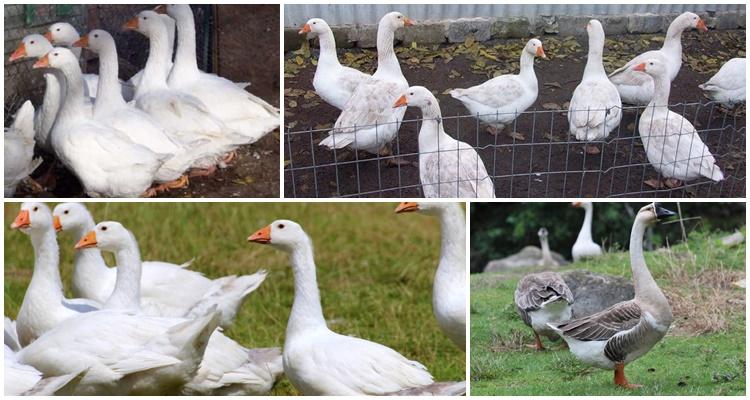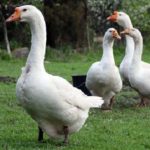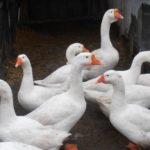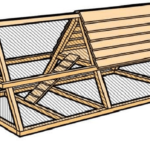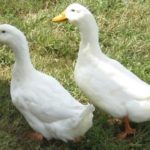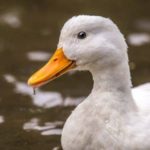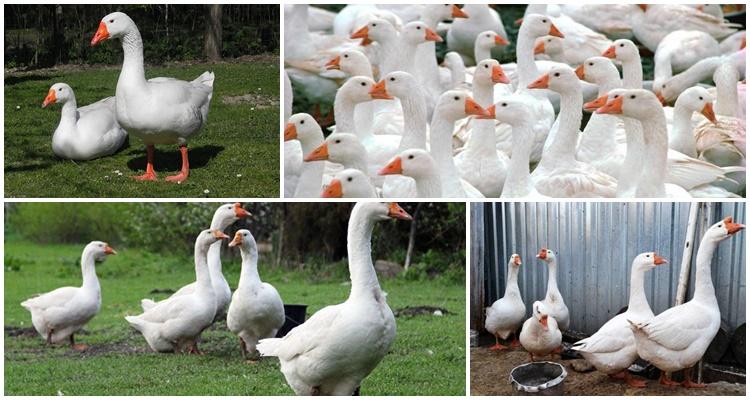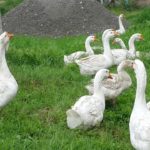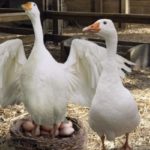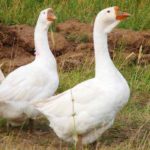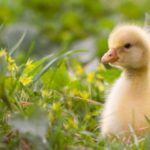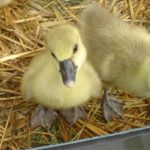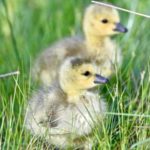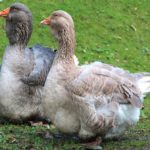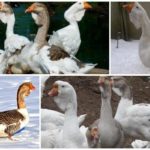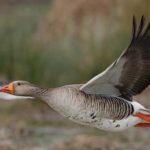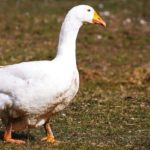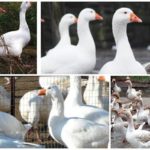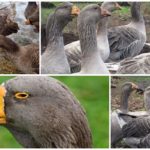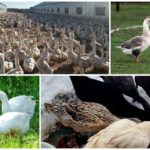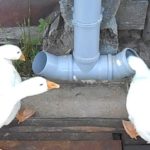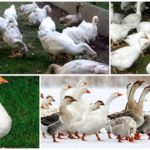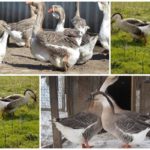A breed of geese called Linda belongs to the category of one of the most popular cross breeds. It shows high performance in various parameters. The breed is purchased for growing at home, as well as for breeding on large farms for profit. The peculiarity of geese is the stability of egg laying, rapid weight gain and resistance to diseases.
Characteristics and appearance
The birthplace of the breed is the Nizhny Novgorod region.The goal of the breeders was to obtain a highly profitable breed that was resistant to numerous avian diseases. The cross is successfully bred in Russia, as well as in Europe.
External description of Lindov's geese:
- large muscular body, wings tightly pressed to the body;
- the plumage is white with beige-gray tan marks;
- a head proportional to the body with dark eyes and a bright orange beak;
- Widely spaced paws of a dark orange hue.
The average weight of poultry raised for slaughter is 8 kilograms. When they reach old age, geese reach 12 kilograms. When purchasing individuals for breeding, it is important to distinguish males from females. The goose looks smaller compared to the adult male. The weight of a goose usually does not exceed 7 kilograms.
The advantage of the Linda breed is considered to be the gentle disposition of the birds. They are calm, peaceful towards their relatives, and are also able to get along with other breeds of geese. Lindovians are not prone to displaying aggression; they are almost not noticed when trying to pluck feathers, as happens in individuals of related breeds.
Males do not start fights and can enter into conflicts only when danger threatens females and offspring. Both sexes are friendly towards people and are kind to their owners. Females incubate the eggs on their own. Some breeders note that they periodically throw eggs, so it is better to use artificial incubators for breeding. The survival rate of Linda breed chicks is high, reaching 90 percent.
Productivity and profitability
A feature of the Linda breed is the absence of a negative quality characterizing productivity, which refers to a decrease in growth rates during molting. In Linda, the rate of body weight gain does not decrease with the onset of plumage change. By 8 months, birds reach sexual maturity. From this moment on, the geese are ready for mating and further reproduction. In one season, the female delivers from 50 to 70 eggs. When comfortable conditions are created, the female shows maximum egg production.
When raised for meat, birds are fattened to 5 kilograms. Birds reach this weight by the time they live for 4-5 months.
Advantages and disadvantages of the breed
The choice of breed is determined by an analysis of the advantages and disadvantages.
| pros | Minuses |
| Rapid weight gain, which is characterized as precocity. With full feeding, by the age of 1 year the goose reaches a weight of 8 kilograms. | Requirement for regular walking, mandatory presence of a pond |
| Increased egg production of geese | Susceptibility of geese to vitamin deficiencies |
| Disease resistance of geese, good immunity | Possible intestinal infections when transferring geese from one type of food to another |
| Taste of meat and eggs | |
| The calm nature of geese of both sexes |
Breeders consider the bird's ability to quickly gain weight to be an advantage of the breed. At the same time, large geese do not lose the ability to actively move while walking, which makes it possible to obtain a carcass with equal levels of fat and meat.
Rules for keeping Linda geese
To get maximum profit, you must follow the maintenance rules. The bird should be provided with comfortable conditions for full growth and development.
Housing
When organizing your stay, you should take into account that 1.5 heads require 1 square meter of space.Nests are created in dark corners without the possibility of through winds. For 3-4 geese, common nests are made with plywood sides. Wood shavings are scattered at the bottom of the nests, and the nests are insulated with additional materials.
Indoors it is necessary to maintain 12-13 hours of daylight. In summer, artificial additional lighting is not required. In winter, additional lamps are provided so that the bird receives enough light. For a small poultry house, 1 window is enough, but as the area increases, 1 additional window is required to ensure maximum daylight.
Reference! It is customary to cut one window next to the door from the poultry house.
Feeding
Raising Linda poultry at home involves preparing a seasonal, complete diet. Geese need to be fed three times daily, with free access to the drinking bowl. The rules for organizing feeding are related to the season:
- In the summer, the geese are out for a walk and feed on plant foods on their own. In the evening they are supplemented with legumes and cereals and given dry food to stabilize the balance and increase the digestibility of food.
- In winter, geese are fed three times. For the diet, balanced feed is selected, to which potatoes, raw yeast, grass, and hay are added.
To increase the natural immune response, special mineral and vitamin complexes containing elements necessary for growth are added to food in spring and autumn.
Reference! Rapid weight gain is achieved by using dry broiler feed.
Place to exit
The breed requires regular walking. The optimal grazing option is the space where cereal crops were previously grown.To increase productivity, it is recommended to arrange grazing areas next to small dams or artificially created reservoirs. For home breeding special pens are built for geese, the boundaries of which are fenced with low fences. In these conditions, it is enough for the birds to install drinking bowls and regularly provide the birds with clean water.
Reference! While grazing, geese need access to drinking bowls, as well as the opportunity to hide from the sun in the shade.
Care
Complete care means creating comfortable conditions and providing a nutritious diet. To ensure that the goose quickly gains weight and the female lays eggs, a windless, comfortable poultry house is built for them, and in the warm season they are walked outdoors with the obligatory presence of a pond nearby.
Breeders adhere to certain rules when leaving:
- A bird is taken to slaughter if it has reached 5-6 kilograms in weight. Females valuable for oviposition are left untouched, but feed intake is controlled, excluding excessive supply of high-calorie food.
- The breeding process begins at the end of February, it can last until the beginning of June. This period is characterized by the fact that the female lays 1 egg daily. Eggs are stored at a temperature of + 5 degrees, turning daily by hand.
- Young animals are looked after especially carefully. The first days of life, the goslings remain close to their mother, then they are gradually weaned off this. Chicks in the first months are shy, they require special attention and care.
Reference! During the time when young animals switch from one type of feeding to another, the risk of intestinal infections may develop.
Subtleties of breeding
Before you start breeding geese, you should familiarize yourself with the breeding rules.Content requires some effort and expense. After the goslings are completely dry, they are taken out of the nest and the umbilical cord is cauterized with iodine. The young animals are kept in a separate poultry house at a temperature of +27 degrees. For 10 days in a row they need additional round-the-clock illumination. Gradually, the illumination intensity is reduced; by 3 months of life, the duration of daylight hours is reduced to 14 hours.
Until 1.5 months of age, goslings are not taken outside, then they begin to be given access to an open container with water. For a full walk in the air, goslings that have reached 50 days of age are released.
Reference! When raising young animals, loud, frightening sounds must be avoided.
What do Linda geese get sick with?
The breed is resistant to infections, but various violations can lead to the spread of diseases.
The Linda breed is susceptible to the following diseases:
- Salmonellosis. A dangerous disease that develops in goslings aged 1 month. To avoid infection, young animals are not allowed to walk until they reach 50 days of age. Infection is transmitted through droppings or infected adults. Alarming symptoms include loss of appetite, loss of coordination of movements, and the appearance of sudden lameness. Lack of treatment can lead to damage to the nervous system and death of the bird.
- Viral enteritis. Caused by direct contact with a carrier of the virus, risk factors include overcrowding and violation of living conditions. Enteritis is manifested by loss of appetite, lack of voice, and the onset of uncontrollable diarrhea. The danger of the disease is that an infected individual can infect its neighbors in a matter of minutes.
- Hymenolepidosis. The disease belongs to the category of parasitic diseases.The causative agent is a worm that quickly penetrates the bird through contaminated food or drink. Geese lose their appetite, quickly lose weight, and become lethargic. To get rid of the parasite, special antiparasitic therapy is carried out.
Home breeding of Linda geese involves systematic vaccinations prescribed by veterinarians. This will avoid various infections and save the bird from common ailments.

